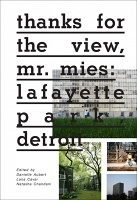Shop > Artists' Books
#11897
Thanks for the View, Mr. Mies: Lafayette Park, Detroit
- Date
- 2012
- Publisher
- Metropolis Books
- Format
- Artists' Books
- Size
- 6.5 × 9.5 inches
- Length
- 288 pages
- Genre
- Essays, Architecture, Interview
Edited and with text by Danielle Aubert, Lana Cavar, Natasha Chandani.
Lafayette Park, an affordable middle-class residential area in downtown Detroit, is home to the largest collection of buildings designed by Ludwig Mies van der Rohe in the world. Today, it is one of Detroit’s most racially integrated and economically stable neighborhoods, although it is surrounded by evidence of a city in financial distress. Through interviews with and essays by residents; reproductions of archival material; and new photographs by Karin Jobst, Vasco Roma, and Corine Vermeulen, and previously unpublished photographs by documentary filmmaker Janine Debanné, Thanks for the View, Mr. Mies examines the way that Lafayette Park residents confront and interact with this unique modernist environment. Lafayette Park has not received the level of international attention that other similar projects by Mies have. This may be due in part to its location in Detroit, a city whose most positive qualities are often overlooked in the media. This book is a reaction against the way that iconic modernist architecture is often represented. Whereas other writers may focus on the design intentions of the architect, authors Aubert, Cavar and Chandani seek to show the organic and idiosyncratic ways that the people who live in Lafayette Park actually use the architecture and how this experience, in turn, affects their everyday lives. While there are many publications about abandoned buildings in Detroit and about the city’s prosperous past, this book is about a remarkable part of the city as it exists today, in the twenty-first century.



































